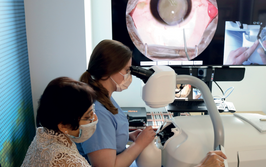The Realities of ChatGPT
Evaluating the use of large language models in ophthalmology
Jay Chhablani | | 4 min read | Opinion

Credit: Headshot supplied by Jay Chhablani
Though there are multiple large language models (LLMs) available today, ChatGPT has solidified its position as the leader in both commercial utilization and clinical evaluation. Could the developers have known this would happen? The answer is a matter of speculation, but people now turn to ChatGPT as a substitute for conventional search engines – like Google – which highlights its indispensability as a fundamental element of everyday online interaction.
From a clinical and care-based perspective, ChatGPT (or similar LLMs) can not only formulate routine medical questions for our patients, but also provide answers to clinical situations for physicians. With GPT-4, the latest version, users can even integrate images with their prompts. Imaging is, of course, a crucial part of diagnostics across various medical stratifications, and ChatGPT’s capacity in this area has immense potential.
Alongside the integration of “plug-ins,” ChatGPT can also search the internet for the timely verification of sources; as a researcher, I would find this tremendously helpful. Furthermore, file uploading, code generation, and execution features are additional aspects that one can add to other systems. This means ChatGPT can write and execute Python code to answer questions with a computational component – an ability that is particularly useful in research and data analysis.
Today, LLMs are being used to screen patient databases to reduce the burden on clinical research teams. One area I’m personally excited about is their ability to integrate tools like Abridge or Augmedix that produce transcripts from conversation in the clinic, while also making notes in electronic health records. Imagine the hours of work this could save!
LLMs have shown – and are continuing to show – impressive performance results at clinical tasks, with GPT-4 scoring 81 percent on the Ophthalmic Knowledge Assessment Program without specific medical training. However, there are concerns; namely, the clinical reasoning remains below expert-level and LLMs often “hallucinate” or confidently provide false but reasonable-sounding information.
We must also exercise caution when using ChatGPT in tasks such as paper summarization, paper editing, idea generation, and even data analysis because of the potential for plagiarism. In fact, many of the ophthalmology journals are not reviewing research regarding LLMs. Yet, at the same time, journals are changing their policies and aiming for stringent actions on LLM-assisted manuscript writing.
The excitement about the technology does come with some downsides. LLMs could enhance equity by bridging language barriers and improving accessibility, but we need to acknowledge how these models perpetuate subtle biases, reflecting imperfect training data and datasets that insufficiently capture marginalized communities. Furthermore, GPT-3.5, which is available for free, has been shown to have poorer performance than GPT-4, which is currently only available with a paid subscription. These paywalls can increase disparity by limiting access to information.
Learning, practice, and research in medicine will inevitably change as a result of LLMs. Currently, we’re in the debate phase; many people still fear the change this approach could yield. But there are certainly clear benefits of integrating this technology in the medical field. For example, it can help patients feel more empowered and educated in their diagnoses, and could help physicians with documentation and communication. However, different LLMs provide different levels of details – not to mention the variations in accuracy and applicability.
In the future, these models could augment established databases – like PubMed – or be integrated into existing emergency medical retrieval services. The increasing use of such technology across ophthalmology – in clinics, in research, and in public health – is already evident. But, as with the integration of any other technology, careful consideration must be given before adopting it; data safety, legal liabilities, and ethical implications loom large. What’s clear is that AI technology will continue to evolve – and AI is here to stay!
Jay Chhablani, Professor of Ophthalmology at the University of Pittsburgh, and
Director of Clinical Research at the UPMC Eye Center.













